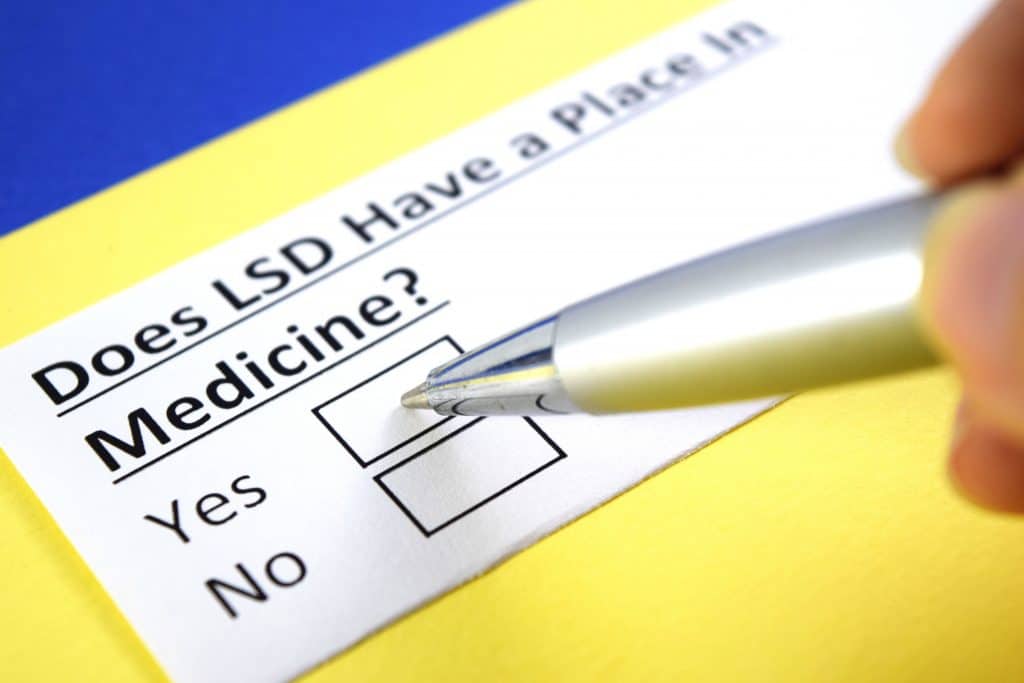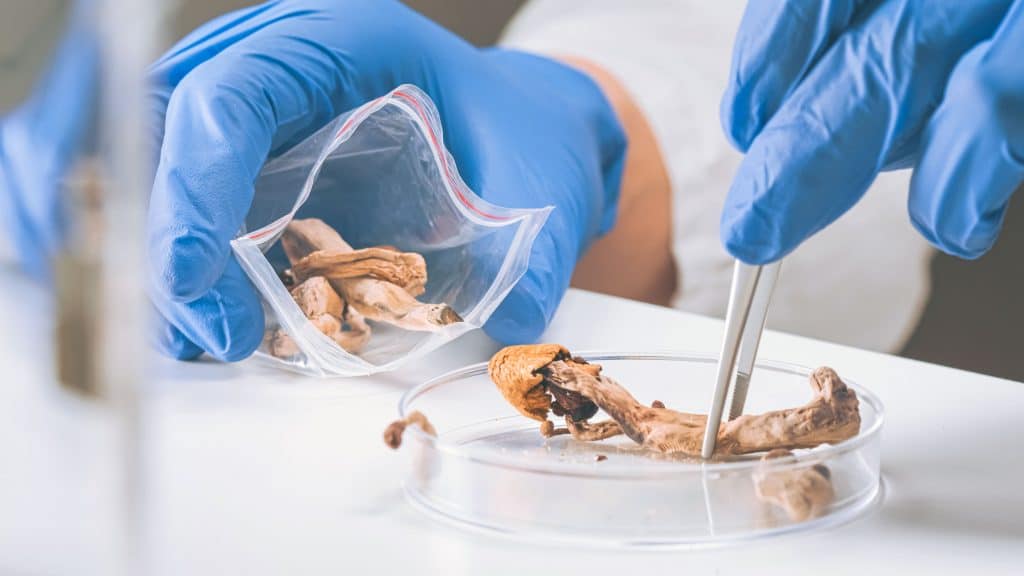Psychedelics and mental health are big news these days; and LSD is a part of it. Though much was established about the compound last century, new research into LSD today shows its ability to help with major depressive disorder, among other psychological issues. Read on for more information about the Phase II trials recently completed, and what we can expect from this compound in the future.
LSD new research
This new research into LSD comes out of Switzerland, where trials were conducted between University Hospital Basel and University Hospital of Psychiatry. The trials were run by the biopharmaceutical company MindMed. The study is a “Randomised, double-blind, active-placebo-controlled trial using either two moderate to high doses of LSD (100 µg and 100 µg or 100 µg and 200 µg) as intervention and two low doses of LSD (25 µg and 25 µg) as active-placebo control.”
The trials used 60 adults above the age of 25 years. All were diagnosed with major depressive disorder (MDD) according to DSM-V standards. The main outcome, according to investigators, was “Change in depressive symptomatology (IDS, BDI), anxiety (STAI), and general psychopathology (SCL-90) compared with active-placebo-assisted psychotherapy.”
In order to find this, the study investigators used a few different measurement techniques. They used the Inventory of Depressive Symptomatology, both clinician-rated and self-rated. They also used the Beck Depression Inventory, the State-Trait Anxiety Inventory for looking at change in state and trait anxiety; the Symptom Check List to look at any change in general psychopathology; the Existential Concerns Questionnaire for measuring existential anxiety; the Five Facet Mindfulness Questionnaire to assess changes in mindfulness; and a host of other tests.
Nice to see you! Head over to the Cannadelics Weekly Newsletter for regular updates; and a host of awesome promotions on cannabis buds, vapes and smoking devices, edibles, cannabinoids, amanita mushroom products, and a massive variety more. We promote feeling good. Come do it!
Some of the other things looked into by the other questionnaires included judging levels of humility, “absorption”, altered states of consciousness, mystical experiences, new physical conditions, perception of therapeutic alliance, mood, personality, religious beliefs, and ongoing effects of treatment.
Investigators also took note of physiological responses via different tests. These tests covered things like the changes in brain-derived neurotrophic factor, changes to hypothalamic-pituitary-adrenal function, immunoregulation and Inflammation changes, brain activation related to fearful face processing and working memory processing, brain perfusion during treatment, and changes in sleep patterns.
Details of the trials
We know this is a study where participants were given LSD as a treatment. But what exactly does this mean? And what about all the terms mentioned above? As a ‘double blind’ study, neither participants nor investigators knew which group each participant was in, control or experimental. The experimental group was the group given the higher dose to assess effects, whereas the control group in this scenario, was simply given a lower dose of the same thing.
‘Randomized’ means that the participants were randomly assigned to their groups, with no reason for entrance into one over another. ‘Active-placebo-controlled’ means that a control group was used that got something similar to the experimental group, but not the same exact treatment amount. ‘Phase II’ means the trials were meant to further elucidate how effective the medicine is, and how safe; with initial trials already completed.
In terms of how it was done, the experimental group was given 100 μg of lysergide the first time around, and 200 μg the second. These two doses were given about four weeks apart. The control group participants received 25 μg the first treatment day, and the same on the second, spaced the same way as the experimental group.
Investigators wanted to know the outcome at week six; this means six weeks after the first dose, and two weeks after the second. The primary outcome measured was change in MDD, which was assessed via the Inventory of Depressive Symptomatology. Investigators also looked at secondary outcomes, which were measured according to self-rated improvements on different scales like Inventory of Depressive Symptomatology, Beck Depression Index, and State-trait anxiety inventory.

After the first dose, patients were followed-up with for 16 weeks. This is important to understand. Trials end, which means the data collection for them ends as well, unless a later follow-up date is set to analyze results past that point. When results therefore say that effects lasted up to 16 weeks after administration, its not saying that the results faded at that time, so much as they weren’t accounted for past that time.
MindMed explanation of trials
On April 23rd, MindMed released topline data on this research, as per BusinessWire, which related that this data “demonstrated significant, rapid, durable and beneficial effects of lysergide and its potential to mitigate symptoms of MDD.” The write-up went on to explain that the high dose regimen led to statistically and clinically significant results on the Inventory of Depressive Symptomatology at the six week mark as compared to the control group. This change was seen up to 16 weeks after the first dose was given, but was not checked after that point.
It should be noted that MindMed’s investigational drug was tolerated well. Not only do these trials aim to see if a medication is able to accomplish something, but whether it can do so while not causing a bunch of negative effects. Investigators did track “adverse events, changes in vital signs, and laboratory values” to make that assessment.
Said Chief Executive Officer and Director of MindMed, Robert Barrow, “We continue to be encouraged by the positive results being generated on the clinical activity of lysergide by our collaborators at UHB. The statistically and clinically significant improvements observed in this study reinforce preliminary findings that have shown the clinical potential of lysergide in anxiety, depression and other brain health disorders.”
Study collaborator Prof. Matthias Liechti added this about how the study came about, “Historical studies of lysergide in MDD demonstrated rapid, robust and sustained improvement in depressive symptoms… We believed it was necessary to confirm the historical studies with ones using modern methods. Hence, we designed this randomized-controlled trial to assess the benefits of lysergide treatment in MDD.”
He continued, “Importantly, an active small dose of lysergide was used as the control. We are extremely encouraged by the results we presented today, which demonstrate the strong, rapid and enduring improvements of this compound in patients suffering from MDD. We look forward to publishing the completed results in a peer-reviewed journal along with additional analyses. Our lab will continue investigating the therapeutic potential of lysergide and other psychedelics.”

What else do we know about LSD?
Though today’s modern world of medicine might make you believe we simply didn’t know about the beneficial effects of LSD, this is not true at all. In recent years, studying it picked back up, but this really started back in the 1900’s. Originally the compound was synthesized by Albert Hoffman in Switzerland in 1938. It wasn’t until the 1950’s, however, that it became big in the world of US psychotherapy.
One of the best known treatment providers and researchers for LSD, was Dr. Humphry Osmond. He concentrated on using LSD for treating both alcoholism and mental disorders. The research on the former provides some of the best information out there on alcohol cessation, even if its not mentioned much today. Osmond, like many others, tested the drug out on himself before administering it to patients. He was the one that coined the term ‘psychedelic.’
His most important work was in conjunction with Abram Hoffer, and called the Saskatchewan trials. These took place at Weyburn Mental Hospital in Saskatchewan, Canada. In total, over 2,000 patients with alcoholism were treated by the end of the 1960’s; with an overall (and pretty amazing) statistic that approximately 40-45% did not drink again within a year of treatment.
Matthias Liechti made an interesting point when he brought up wanting to create new research into LSD to test the same things tested back-in-the-day. The real story is that while a lot of information exists, the medical world tends to erase or ignore it; and treats the topic like it didn’t become a thing until the past few years.
Conclusion
We see legalizations for mushrooms, and other entheogenic plants, happening in different places. We even see a preemptive legalization of MDMA. Owing to this new research into LSD, and its known-about uses for treating alcoholism and other mental disorders; its very likely that LSD medications will be the next big topic of mental-health conversations.
Welcome everyone. We’re happy to see you at Cannadelics.com; where we work hard to bring you the best in independent reporting for the cannabis and hallucinogen spaces. Join us daily to stay in-the-know on important topics, and sign up to the Cannadelics Weekly Newsletter, so you’re always up on what’s going down.
The post LSD Will Turn That Frown Upside Down, According to New Research appeared first on Cannadelics.
Via https://cannadelics.com/2023/05/06/lsd-will-turn-that-frown-upside-down-according-to-new-research/
source https://rosalinaklerkx.weebly.com/blog/lsd-will-turn-that-frown-upside-down-according-to-new-research
No comments:
Post a Comment